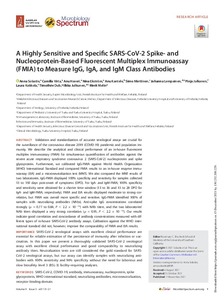A Highly Sensitive and Specific SARS-CoV-2 Spike- and Nucleoprotein-Based Fluorescent Multiplex Immunoassay (FMIA) to Measure IgG, IgA, and IgM Class Antibodies
Solastie Anna; Virta Camilla; Haveri Anu; Ekström Nina; Kantele Anu; Miettinen Simo; Lempainen Johanna; Jalkanen Pinja; Kakkola Laura; Dub Timothée; Julkunen Ilkka; Melin Merit
A Highly Sensitive and Specific SARS-CoV-2 Spike- and Nucleoprotein-Based Fluorescent Multiplex Immunoassay (FMIA) to Measure IgG, IgA, and IgM Class Antibodies
Solastie Anna
Virta Camilla
Haveri Anu
Ekström Nina
Kantele Anu
Miettinen Simo
Lempainen Johanna
Jalkanen Pinja
Kakkola Laura
Dub Timothée
Julkunen Ilkka
Melin Merit
American Society for Microbiology
Julkaisun pysyvä osoite on:
https://urn.fi/URN:NBN:fi-fe2022012710642
https://urn.fi/URN:NBN:fi-fe2022012710642
Tiivistelmä
Validation and standardization of accurate serological assays are crucial for the surveillance of the coronavirus disease 2019 (COVID-19) pandemic and population immunity. We describe the analytical and clinical performance of an in-house fluorescent multiplex immunoassay (FMIA) for simultaneous quantification of antibodies against the severe acute respiratory syndrome coronavirus 2 (SARS-CoV-2) nucleoprotein and spike glycoprotein. Furthermore, we calibrated IgG-FMIA against World Health Organization (WHO) International Standard and compared FMIA results to an in-house enzyme immunoassay (EIA) and a microneutralization test (MNT). We also compared the MNT results of two laboratories. IgG-FMIA displayed 100% specificity and sensitivity for samples collected 13 to 150 days post-onset of symptoms (DPO). For IgA- and IgM-FMIA, 100% specificity and sensitivity were obtained for a shorter time window (13 to 36 and 13 to 28 DPO for IgA- and IgM-FMIA, respectively). FMIA and EIA results displayed moderate to strong correlation, but FMIA was overall more specific and sensitive. IgG-FMIA identified 100% of samples with neutralizing antibodies (NAbs). Anti-spike IgG concentrations correlated strongly (ρ = 0.77 to 0.84, P < 2.2 × 10-16) with NAb titers, and the two laboratories' NAb titers displayed a very strong correlation (ρ = 0.95, P < 2.2 × 10-16). Our results indicate good correlation and concordance of antibody concentrations measured with different types of in-house SARS-CoV-2 antibody assays. Calibration against the WHO international standard did not, however, improve the comparability of FMIA and EIA results. IMPORTANCE SARS-CoV-2 serological assays with excellent clinical performance are essential for reliable estimation of the persistence of immunity after infection or vaccination. In this paper we present a thoroughly validated SARS-CoV-2 serological assay with excellent clinical performance and good comparability to neutralizing antibody titers. Neutralization tests are still considered the gold standard for SARS-CoV-2 serological assays, but our assay can identify samples with neutralizing antibodies with 100% sensitivity and 96% specificity without the need for laborious and slow biosafety level 3 (BSL-3) facility-requiring analyses.
Kokoelmat
- Rinnakkaistallenteet [27094]
